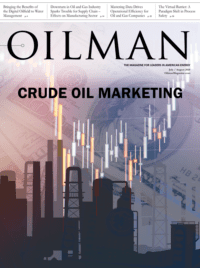Digital transformation of the oil and gas industry is no longer a question. At this point, if any company underneath the industry umbrella (production, engineering, construction, just to name a few) has not converted in some way, they are not only late to the game, they are more than likely on their way out of the game. The AI and Machine Learning capabilities on the market today are many. Every effort must be made to dissect the inner workings of an oil and gas discipline and figure out which company can not only meet, but exceed, their needs.
There are two companies that we wanted to take a deep dive look into their approach when it comes to digital transformation. Both companies are forces in their field and we were able to explore what they have to offer this complex industry. We’re already aware of many of the benefits of AI, but there is still so much to learn about this fascinating concept.
The first company, Kinsmen Group, has a leading team of Engineering Information Management Specialists that specializes in engineering/asset information and document control services and solutions. I spoke with Edwin Elmendorp, Information Architect at Kinsmen Group, and he provided some insight on the concept of digital twin technology, among other things.
Digital Twin Technology
Digital twin technology is a concept where different technologies (digital and physical) are used and combined to create a holistic digital replica in fine detail of a real and complex asset. This digital replica (twin) is a dynamic model, which can be used to simulate past and future versions of the asset to better predict facility output, equipment reliability, safety issues, as well as provide remote training and other use-cases.
Having access to this kind of technology can revolutionize a company. Edwin Elmendorp explained this well. “Transforming a business is not just about changing from a manual (paper) to a digital process; it’s looking at the whole value chain and reinventing how that value chain operates and implement changes that disrupt the current operational model to be faster, safer, more reliable, etc. For oil and gas, that value chain consists of service providers, equipment manufacturers, and many more. The digital twin allows them to be closer to the real world environment and provide different (outsourced) service models – previously impossible due to technology limitations. Think of an equipment vendor who can remotely monitor a complex piece of machinery and early detect potential failures and recommend maintenance. The experience of the vendor far exceeds that of the owner, who can cut costs in specialized labor. The vendor’s economy of scale provides benefits for both parties. Additionally, because of the Machine Learning and AI being applied in these models (similar to a generative design) decisions are faster and more accurate, with a larger team of experts more easily involved – from equipment suppliers remotely monitoring critical equipment, too.”
Seven Summits
Kinsmen Group implemented a thought-provoking and out-of-the-box concept of something they called the “Seven Summits Tour” – identifying seven critical areas to success (based off the tallest peaks of each of the seven continents). The objective was to interactively road test the model to enable readers to get a grip on the many factors affecting the accessibility and integrity of engineering information by dealing with today’s immediate issues and planning for the immediate and longer-term future. This was a challenge that helped to understand how companies operate and identify the challenges they face.
“The seven summits tour provided a high-level understanding of where companies are, and where they are not. The events during the tour provided the opportunity to discuss with multiple companies for a limited amount of time. It mostly generated a much better awareness and also validation of the concepts. Since then, it has resulted for a number of customers in a deeper engagement to measure their EIM maturity and translate this to actionable projects that are aligned with company strategy and business goals to operate more safely and reliably,” Elmendorp said.
Machine Intelligence
Hypergiant is another technology company that has an unorthodox approach. If you go to their website, you will find leaders in Machine Intelligence, with an impressive record of tailoring solutions for clients in fields ranging from oil drilling and fluid dynamics to entertainment and healthcare, all from a user-centric perspective marrying business needs with user needs. The company primarily sells customized products for clients in the oil and gas industry and has built predictive market models, computer vision power solutions, and document recognition tools for a host of top oil and gas companies around the world.
To truly understand what goes into learning the inner workings of a company and recognize the weakness in their infrastructure, Hypergiant explained its process through the following statement:
At the most basic level, companies looking for AI solutions are generally trying to [find solutions] for legacy systems that have broken or looking for efficiency gains through data. So, when they come to us, we start by working to understand what the business challenges are and the complexity of the current issue before we ever think of offering one of our products or building something new. Sometimes, we help identify a human-system problem that needs to be resolved with infrastructure changes before we can even think about a technical solution.
We have a fairly dynamic process for evaluating customer’s needs in order to build solutions. Our first step is investigation: what is the company trying to solve, how have they done it in the past, and what data do they have? Then, we explore and survey: as an AI-focused company, we need to understand the state and structure of the data to determine how it can be processed. This step is about predicting or determining better paths for the business. To do this, we review the data while also hosting professionally guided user interviews conducted by our product managers and designers to ensure we understand the data and how it’s used and also who is using the data. We want to not just improve the data sources, the data used, and the solution to a problem, but also [determine] how we can improve their experience of working with and using that data. Only then do we begin to build solutions for our customers. From there, the process can range from a few months to a few years to develop best-in-class product solutions.
Common Logistical Problems the Industry Faces
A good deal of the logistical problems faced by oil and gas companies – inventory management, market awareness and projections, maintenance and upkeep of various facilities, transportation, import and export operations – are filled with useful data patterns that can be leveraged to streamline the business. For Hypergiant clients, they’ve done quite a bit of predictive market analysis where they’ve modelled what their competitors’ data will most likely look like based on historical data and where their own current data is trending (with accuracy in the high 90 percentile). They’ve built computer vision powered solutions that could ingest data from drones or satellites, combined with sensor data to identify everything from the most likely candidate for repair in a pipeline that has just suffered a major weather event to which very large and expensive piece of gear is actually stored closest and will cost the least to replace a worn part at a local drill site. They’ve also streamlined document recognition to better process all the paperwork associated with managing physical goods. They’ve built human-augmented ticketing systems that intelligently assign maintenance work to the best field worker for the job, while recognizing the individual performance and motivating them to keep up the good work through intelligent incentives built into mobile edge solutions, complete with connectivity heat maps that tell them the closest location they need to move to “phone home,” to the main network to get their next ticket. For a major oil company, specifically, they worked on a digital production AI tool that takes the knowledge and expertise that a strong production supervisor has and turns it into a tool that can assist with decision-making, helping them move beyond their reliance on dashboards.
“AI is not magic, it’s just work. It is also not a new thing. I know it’s sexy right now and people are excited about it, but it’s really more of a magic bullet. It’s a different look at how you’re leveraging and organizing data,” Ben Lamm, founder and CEO of Hypergiant.
Revolutionary Solutions
Knowledge and information are power. To help with a company’s success, you must reach out and go beyond the normal mundane routine of checking boxes. Hypergiant and Kinsmen Group have figured this out. Companies are unique; what will be perfect for one wouldn’t work for the next – even in the same industry. AI and Machine Learning have been around. It’s time that they become more revolutionary and evolve, the way they’re asking the oil and gas industry to do the same.
Sarah Skinner is a graduate of Louisiana State University with a degree in English. She has been a technical writer and editor in the oil and gas industry for over ten years in Houston and in Louisiana. She currently works as a technical writer for a pre-cast concrete construction company in Louisiana that builds blast-proof buildings for petrochemical plants.







